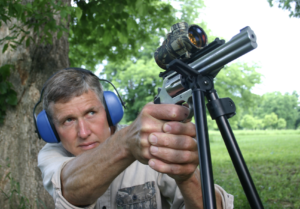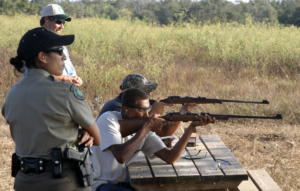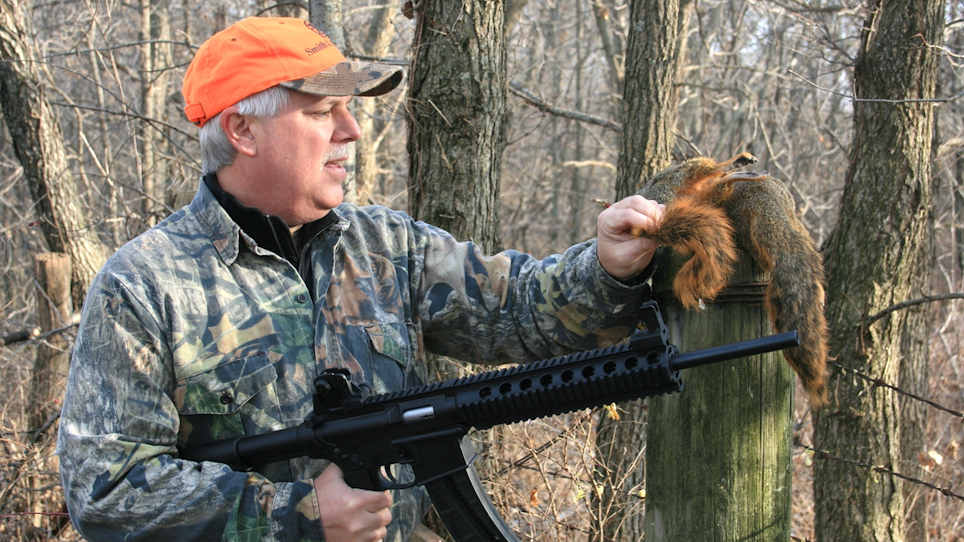Once upon a time in America, that first firearm for nearly every beginning shooter or hunter was a .22 bolt-action rifle — the ultimate rimfire. Millions of new shooters have experienced their first shot with a .22 caliber rifle.
Now that .22 ammunition is available, it is time to again talk about rimfires with customers. The great news is there’s a lot to talk about. From the exciting .22 rimfire leagues in place across America to thrilling small bore precision rifles, rimfires have rebounded. Hunting and plinking rimfire shooters are also waiting to hold and load another rifle or pistol.
Are your customers primed for the return of the rimfires?
It’s well known that the most common rimfire — the .22 calibers — are fun to shoot, are generally more affordable than some other calibers (both ammunition and the firearm), deliver less recoil and report and provide other shooter friendly benefits. When shown a .22 cartridge or a much larger .30-06 cartridge, beginning shooters focus on the .22 because it looks and is more manageable. While .22 caliber firearms may seem tame, however, remember that the standard range for a .22 caliber bullet is a mile. Safety first.
Now more good news.
The Best Beginner
The .22 rimfire (and the less common .17 calibers) are a good way to introduce young shooters and beginners to the shooting sports. Smarter retailers often sell the firearm as part of a package that includes ammunition, eye and ear protection, a gun case, some targets and possibly a range bag. Make the buying decision as easy as possible since this is often the first purchase — or a first shooting experience in many ways — for a large segment of rimfire customers. Make a product mix that meets their needs and wallets.

Rimfire pistols for hunting or plinking are great fun, and with ammuntion available again customers will be seeking assistance with products. Be ready for the return of rimfires and make more sales. (Photo: Michael Faw)
Wondering about the drivers behind rimfire markets? Several state-mandated hunter education and firearms safety courses require that each student shoot at least 10 rounds through a .22 caliber rifle. Thus, those shooters and possible customers have experience with rimfires and know what to expect. While some departments provide the firearms, others require that the instructor provide the firearms and ammunition. If you have a range, that could be a market segment you reach out to and that welcomes new shooters and customers. Learn the details and serve this often-overlooked segment.
Scouts and other widely recognized programs such as 4-H also use .22 rifles in their shooting programs. Some American Legion halls, rural churches and other civic groups have programs to introduce today’s youth to shooting and firearms safety. The rimfire rifle is the firearm of choice for most of those. Ask around your community and do the profit calculations to determine if this group could become a welcome customer base and register ringer.
While sales can focus on those beginning shooters and first-time gun buyers, don’t neglect the experienced shooter, plinkers and target shooters. Plinkers, those shooters who just want to relax and shoot some type of target on the back 40 acres, are top markets for rimfires. This group also uses a large amount of ammunition on an annual basis.
The rimfire market is a diverse customer base. It spans across markets and interests you may already be successful serving. In addition to hunters and recreational shooters (plinkers), the customers could be competitors, precision shooters, postal match participants or simply long-gun or handgun enthusiasts or collectors.
Hail the Rimfire Firearms
Most major firearms manufacturers offer at least one or more models of rimfire firearms chambered in .22 or 17HMR. Several of those makers also offer tactical .22 rifles. You should expect rimfire shoppers to be looking for a bolt-action, lever-action, semi-auto or a handgun. It’s a well-known fact that interest in air rifles is on the rise, and this is the next step up for those shooters in their natural progression. Consider offering products to these customers, or they could go elsewhere.
Nearly every retailer in the shooting sports arena recognizes the powerhouse rimfire firearms such as the ever-popular Ruger 10-22, Smith & Wesson 15-22 Sport, Browning Buckmark pistols and rifles, Marlin’s lever-action 39A and Remington’s 572 Fieldmaster semi-auto rifle. Your customers know about those firearms. Your customers also know they can find a wide assortment of after-market accessories to make those rimfires more custom to their preferences. Those includes barrels, stocks, triggers, riflescopes and bases, red dot sights and much more. Yes, there are numerous kits to also convert many 1911 pistols from .45 ACP to .22 caliber cartridges.
If you don’t provide gunsmithing services or otherwise can’t meet customer requests with some of these projects, consider working with a reputable gunsmith and offer the accessories — and installations or conversions — for rimfire customers. In many cases, it’s convert the rimfire firearm and capture the customer. And that S&W 15-22 Sport rifle will appeal to those customers who are AR rifle enthusiasts. You probably know your AR enthusiast customers by name and here’s another opportunity to keep them excited and shooting.
In addition to offering rifles in .22 or .17 calibers, think wider to increase your sales and market share. There are numerous rimfire pistols including target models with special grips and barrels and many more revolvers to suit customer preferences. This diverse rimfire firearms product mix will permit you to offer options at numerous price points so you increase the chances of getting a customer to open her or his wallet. This type sale is best made if you can place the firearm or accessory in the customer’s hand and let her or him imagine the hours of fun ahead. Yes, many items in the rimfire arena nearly sell themselves, you just need to draw customer attention to the item.
Sales, however, can also be seasonal on rimfires. Most plinkers purchase a new firearm or more ammunition in the spring when the outdoors calls, there’s a warm sunny afternoon and shooting outside is again comfortable and enjoyable. Hunters start thinking about new rifles as fall approaches. And the precision .22 market starts thinking about rimfires when programs begin — often in spring — or when regional shooting competitions begin. Some of those programs are also based on times to prepare for, or to advance shooters to, national level competitions.
Survey your community and region to determine what to stock and offer to the more precise rimfire shooters. If you truly want to stand out with rimfire enthusiasts, research Olympic biathlons and other precision rimfire shooting events and you’ll note those are far from standard firearms used, and this type shooting requires other highly technical gear such as special jackets, mats, stands and eyewear. Those rimfire shooters are out there and do many firearm and gear upgrades through their shooting careers. More proof that the rimfire market is massive and you can profit by reaching into those many market channels.

Most hunter education firearm safety field days incorporate the .22 rifle, which is a great way to establish a bond with young or new shooters. (Photo: Michael Faw)
Tomorrow’s Rimfire Customers
Now that the much-publicized .22 caliber ammunition hoarding has passed, shooters are shopping. Several firearm manufacturers have taken note of their buying habits and preferences and have offered new .22 caliber firearms in recent years.
The popular Browning Buck Mark .22 caliber pistol is available in nearly a dozen models and colors. More versions of rimfire pistols and more technical .22 rifles are the trend now. The more technical it appears, the more it appeals to today’s new shooter customers. Those passionate plinking customers you had previously never went away, they simply stood on the sidelines to see what was happening with ammunition supplies and manufacturers. Reach out to them again and serve their interests.
Today, many customers are also searching for those rimfire firearms that they read good things about in print and online. That means the next customer at the counter could be a traditional gun owner or possibly a millennial searching for that first firearm. This later customer base seems to be more focused on technical .22s and the vivid colors, nontraditional stocks, lots of rails and many accessories motivate them to purchase. You will need to offer a wide spectrum of accessories to keep them returning and buying.
This younger and technical group of customers is also focused on action. While they will purchase paper targets, they also get excited on the oozing cans, exploding watermelons and other active targets that some manufacturers have brought to market in recent times. Steel targets that spin and plink, and small rubber pest targets on light metal frames also motivate this group to keep shooting. Aisle-end displays with these action targets, the ammunition and a list of the rimfires you have in stock behind the counter can help meet this customer base’s needs and wants, then motivate them to buy now.
If you want more details on the buying habits and preferences of this younger customer base, the National Shooting Sports Foundation has several market reports about new participants and details that can help you make stocking decisions. With a little effort, market insight and extra marketing effort, you could become your region’s rimfire expert or center.
A final note is that rimfire shoppers use ammunition — and lots of it. For the cost-conscious shoppers, standard .22 and .17 ammunition will meet their needs. For the precision shooters, however, plan to provide the premium brands and products to them. They may experiment with ammunition, but mostly focus on premium brands and are willing to pay premium prices — if you offer it. You could move ahead of your regional competition by having the more specialized firearms and ammunition on your shelves.
A Step Back
Another strong rimfire market is the aging American shooting enthusiast who remembers a rimfire rifle their dad or grandad had. The rimfires have history in America, and back in the 1970s famous gunwriter Jack O’Conner recommended that everyone own a .22 rifle. John Browning, who was well known for rifles, shotguns and machine-gun designs, also designed .22 rimfire rifles. One of those early designs continues in production. High Standard and Colt made rimfire firearms in the past that generations grew up shooting and using.
The rimfire rifle was used by the U.S. military in yesteryear to teach shooting skills and prepare troops for battle. While today’s military branches may have moved to other calibers and firearms, rimfires endure. Scouting continues the decades old merit badge program that introduces many new shooters to firearms and the shooting sports. The rimfire interest is out there.
If you do offer rental guns for range use, adding some rimfires could move those reluctant shooters who appear at the sales counter or rental register into the active participant category by eliminating a top obstacle — recoil. This factor is the big one that makes those many rimfire rifles and handguns shine in customer’s eyes.
The rimfire market has returned. Are you ready to be your region’s leading rimfire retailer and accessory resource?
Featured image: Rimfire rifles are making a return for target shooters and hunters, with some choosing the AR-style rifles for squirrel and small game hunting, (Photo: Michael Faw)





